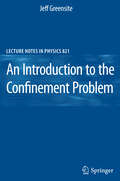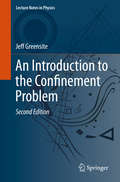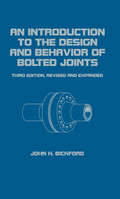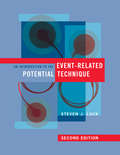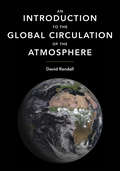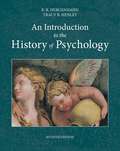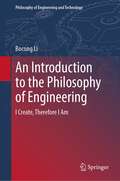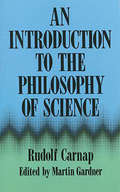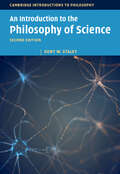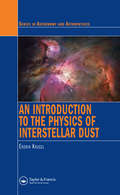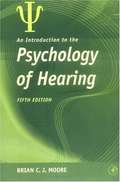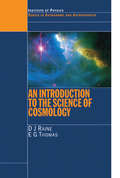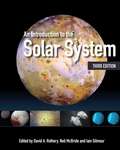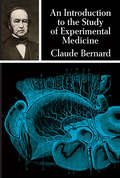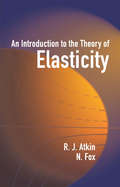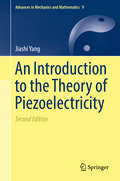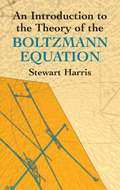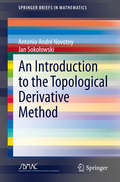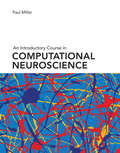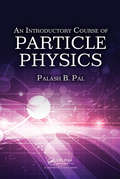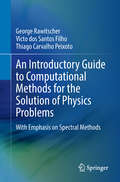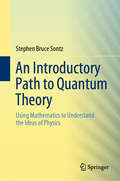- Table View
- List View
An Introduction to the Confinement Problem (Lecture Notes in Physics #821)
by Jeff GreensiteThis book addresses the confinement problem, which quite generally deals with the behavior of non-abelian gauge theories, and the force which is mediated by gauge fields, at large distances. The word "confinement" in the context of hadronic physics originally referred to the fact that quarks and gluons appear to be trapped inside mesons and baryons, from which they cannot escape. There are other, and possibly deeper meanings that can be attached to the term, and these will be explored in this book. Although the confinement problem is far from solved, much is now known about the general features of the confining force, and there are a number of very well motivated theories of confinement which are under active investigation. This volume gives a both pedagogical and concise introduction and overview of the main ideas in this field, their attractive features, and, as appropriate, their shortcomings.
An Introduction to the Confinement Problem (Lecture Notes in Physics #972)
by Jeff GreensiteThis book addresses the confinement problem, which concerns the behavior of non-abelian gauge theories, and the force which is mediated by gauge fields, at large distances. The word “confinement” in the context of hadronic physics originally referred to the fact that quarks and gluons appear to be trapped inside mesons and baryons, from which they cannot escape. There are other, and possibly deeper meanings that can be attached to the term, and these will be explored in this book. Although the confinement problem is far from solved, much is now known about the general features of the confining force, and there are a number of very well motivated theories of confinement which are under active investigation. This volume gives a both pedagogical and concise introduction and overview of the main ideas in this field, their attractive features, and, as appropriate, their shortcomings. This second edition summarizes some of the developments in this area which have occurred since the first edition of this book appeared in 2011. These include new results in the caloron/dyon picture of confinement, in functional approaches, and in studies of the Yang-Mills vacuum wave functional. Special attention, in two new chapters, is given to recent numerical investigations of the center vortex theory, and to the varieties of confinement which may exist in gauge-Higgs theories. Reviews of the first edition: “This is indeed a very good book. I enjoyed reading it and… I learned a lot from it.… It is definitely a research book that provides readers with a guide to the most updated confinement models.” (Giuseppe Nardelli, Mathematical Reviews, Issue 2012 d) “The book is beautifully produced with special emphasis on the relevance of center symmetry and lattice formulation as well as an introduction to current research on confinement.” (Paninjukunnath Achuthan, Zentralblatt MATH, Vol. 1217, 2011)
An Introduction to the Design and Behavior of Bolted Joints, Revised and Expanded (Mechanical Engineering Ser.)
by John BickfordOffering a broad-based review of the factors affecting the design, assembly and behaviour of bolted joints and their components in all industries, this work details various assembly options as well as specific failure modes and strategies for their avoidance. This edition features material on: the contact stresses between bolt head or nut face and the joint; thread forms, series and classes; the stiffness of raised face flange joints; and more.
An Introduction to the Event-Related Potential Technique, second edition
by Steven J. LuckAn essential guide to designing, conducting, and analyzing event-related potential (ERP) experiments, completely updated for this edition.The event-related potential (ERP) technique, in which neural responses to specific events are extracted from the EEG, provides a powerful noninvasive tool for exploring the human brain. This volume describes practical methods for ERP research along with the underlying theoretical rationale. It offers researchers and students an essential guide to designing, conducting, and analyzing ERP experiments. This second edition has been completely updated, with additional material, new chapters, and more accessible explanations. Freely available supplementary material, including several online-only chapters, offer expanded or advanced treatment of selected topics.The first half of the book presents essential background information, describing the origins of ERPs, the nature of ERP components, and the design of ERP experiments. The second half of the book offers a detailed treatment of the main steps involved in conducting ERP experiments, covering such topics as recording the EEG, filtering the EEG and ERP waveforms, and quantifying amplitudes and latencies. Throughout, the emphasis is on rigorous experimental design and relatively simple analyses. New material in the second edition includes entire chapters devoted to components, artifacts, measuring amplitudes and latencies, and statistical analysis; updated coverage of recording technologies; concrete examples of experimental design; and many more figures. Online chapters cover such topics as overlap, localization, writing and reviewing ERP papers, and setting up and running an ERP lab.
An Introduction to the Global Circulation of the Atmosphere
by David RandallThis is a graduate-level textbook on the global circulation of the Earth's atmosphere--the large-scale system of winds by which energy is transported around the planet, from the tropical latitudes to the poles. Written by David Randall, one of the world's foremost experts on the subject, it is the most comprehensive textbook on the topic. Intended for Earth science students who have completed some graduate-level coursework in atmospheric dynamics, the book will help students build on that foundation, preparing them for research in the field.The book describes the many phenomena of the circulation and explains them in terms of current ideas from fluid dynamics and thermodynamics, with frequent use of isentropic coordinates and using the methods of vector calculus. It emphasizes the key roles of water vapor and clouds, includes detailed coverage of energy flows and transformations, and pays close attention to scale interactions. The book also describes the major historical contributions of key scientists, giving a human dimension to the narrative, and it closes with a discussion of how the global circulation is evolving as the Earth's climate changes.The most comprehensive graduate-level textbook on the subjectWritten by one of the world's leading expertsConnects global circulation and climate phenomenaAddresses energy, moisture, and angular-momentum balance; the hydrologic cycle; and atmospheric turbulence and convectionEmphasizes the energy cycle of the atmosphere; the role of moist processes; and circulation as an unpredictable, chaotic processHelps prepare students for researchAn online illustration package is available to professors
An Introduction to the History of Psychology
by B. R. Hergenhahn Tracy HenleyDreams puzzled early man, Greek philosophers spun elaborate theories to explain human memory and perception, Descartes postulated that the brain was filled with "animal spirits," and psychology was officially deemed a "science" in the 19th century. In this Seventh Edition of AN INTRODUCTION TO THE HISTORY OF PSYCHOLOGY, authors Hergenhahn and Henley demonstrate that most of the concerns of contemporary psychologists are manifestations of themes that have been part of psychology for hundreds--or even thousands--of years. The book's numerous photographs and pedagogical devices, along with its biographical material on key figures in psychology, engage readers and facilitate their understanding of each chapter. Available with InfoTrac Student Collections http://gocengage. com/infotrac.
An Introduction to the Philosophy of Engineering: I Create, Therefore I Am (Philosophy of Engineering and Technology #39)
by Bocong LiThis book is the first academic work on the philosophy of engineering in China that reflects two decades of research. It puts forward a new thesis, namely that the core maxim in the philosophy of engineering is “I create, therefore I am,” which is radically different from the Cartesian maxim: “I think, therefore I am.” In addition, the book offers the first detailed portrait of the roots and evolution of the philosophy of engineering in China. The book begins by discussing the triptych thesis of science, technology and engineering, which argues that there are a number of important distinctions between the three, e.g. scientific activities are chiefly based on discovery, while technological activities center on invention, and engineering activities focus on creation. Considering the latest developments in the philosophy of engineering, the author also analyzes engineering communities, engineering practice and a micro–meso–macro framework. In subsequent chapters, the author separately analyzes the three stages of engineering activities: planning, operating and using artifacts. In the closing chapter, two views on the philosophy of engineering (as a new subdiscipline of philosophy and as a philosophy in its own right) are briefly explained.
An Introduction to the Philosophy of Science
by Kent W. StaleyThis book guides readers by gradual steps through the central concepts and debates in the philosophy of science. Using concrete examples from the history of science, Kent W. Staley shows how seemingly abstract philosophical issues are relevant to important aspects of scientific practice. Structured in two parts, the book first tackles the central concepts of the philosophy of science, such as the problem of induction, falsificationism, and underdetermination, and important figures and movements, such as the logical empiricists, Thomas Kuhn, and Paul Feyerabend. The second part turns to contemporary debates in the philosophy of science, such as scientific realism, explanation, the role of values in science, the different views of scientific inference, and probability. This broad yet detailed overview will give readers a strong grounding whilst also providing opportunities for further exploration. It will be of particular interest to students of philosophy, the philosophy of science, and science.
An Introduction to the Philosophy of Science
by Rudolf CarnapOne of the most creative philosophers of the 20th century, Rudolf Carnap presented a series of science lectures at the University of California in 1958. The present volume is an outgrowth of that seminar, which dealt with the philosophical foundations of physics. Edited by Martin Gardner from transcripts of Carnap's classroom lectures and discussions, the book remains one of the clearest and soundest introductions to the philosophy of science.Specially designed to appeal to a wide range of readers, An Introduction to the Philosophy of Science offers accessible coverage of such topics as laws and probability, measurement and quantitative language, the structure of space, causality and determinism, theoretical laws and concepts and much more. Stimulating and thought-provoking, the text will be of interest to philosophers, scientists and anyone interested in logical analysis of the concepts, statements and theories of science. Foreword to the Basic Books Paperback Edition, 1974 (Gardner); Preface (Carnap); Foreword to the Dover Edition (Gardner). 35 black-and-white illustrations. Bibliography.
An Introduction to the Philosophy of Science (Cambridge Introductions to Philosophy)
by Kent W. StaleyThis thoroughly updated second edition guides readers through the central concepts and debates in the philosophy of science. Using concrete examples from the history of science, Kent W. Staley addresses questions about what science is, why it is important, and the basis for trust in scientific results. The first part of the book introduces the central concepts of philosophy of science, with updated discussions of the problem of induction, underdetermination, rationality, scientific progress, and important movements such as falsificationism, logical empiricism, and postpositivism, together with a new chapter on social constructionism. The second part offers updated chapters on probability, scientific realism, explanation, and values in science, along with new discussions of the role of models in science, science in policy-making, and feminist philosophy of science. This broad yet detailed overview will give readers a strong grounding in philosophy of science whilst also providing opportunities for further exploration.
An Introduction to the Physics of Interstellar Dust
by Endrik KrugelStreamlining the extensive information from the original, highly acclaimed monograph, this new An Introduction to the Physics of Interstellar Dust provides a concise reference and overview of interstellar dust and the interstellar medium. Drawn from a graduate course taught by the author, a highly regarded figure in the field, this all-in-one book
An Introduction to the Psychology of Hearing
by Brian C. J. MooreNow available in a Fifth Edition, An Introduction to the Psychology of Hearing is the leading textbook in the field of auditory perceptionalso known as psychoacoustics. The Fifth Edition has been thoroughly updated, with more than 200 references to articles and books published since 1996. <P><P>The book describes the relationships between the characteristics of the sounds that enter the ear and the sensations that they produce. Wherever possible these relationships are specified in terms of the underlying mechanisms. In other words, the goal is to impart an understanding of what the auditory system does and how it works. <P><P>Topics covered include the physics of sound, the physiology of the auditory system, frequency selectivity and masking, loudness perception, temporal analysis, pitch perception, sound localization, timbre perception, the perceptual organization of complex auditory "scenes", speech perception, and practical applications such as hearing aids, cochlear implants, and high-fidelity sound reproduction. <P><P>The book starts from basic principles, and does not assume prior knowledge about hearing. Research results are not just described, but are interpreted and evaluated. The book includes extensive references to recent research so that those interested in a specific area can readily obtain more detailed information.
An Introduction to the Science of Cosmology (Series in Astronomy and Astrophysics)
by Derek Raine E. G. ThomasA thorough introduction to modern ideas on cosmology and on the physical basis of the general theory of relativity, An Introduction to the Science of Cosmology explores various theories and ideas in big bang cosmology, providing insight into current problems. Assuming no previous knowledge of astronomy or cosmology, this book takes you beyond introductory texts to the point where you are able to read and appreciate the scientific literature, which is broadly referenced in the book. The authors present the standard big bang theory of the universe and provide an introduction to current inflationary cosmology, emphasizing the underlying physics without excessive technical detail.The book treats cosmological models without reliance on prior knowledge of general relativity, the necessary physics being introduced in the text as required. It also covers recent observational evidence pointing to an accelerating expansion of the universe. The first several chapters provide an introduction to the topics discussed later in the book. The next few chapters introduce relativistic cosmology and the classic observational tests. One chapter gives the main results of the hot big bang theory. Next, the book presents the inflationary model and discusses the problem of the origin of structure and the correspondingly more detailed tests of relativistic models. Finally, the book considers some general issues raised by expansion and isotropy. A reference section completes the work by listing essential formulae, symbols, and physical constants.Beyond the level of many elementary books on cosmology, An Introduction to the Science of Cosmology encompasses numerous recent developments and ideas in the area. It provides more detailed coverage than many other titles available, and the inclusion of problems at the end of each chapter aids in self study and makes the book suitable for taught courses.
An Introduction to the Solar System
by David A. Rothery Iain Gilmour Neil McBrideOngoing advances in Solar System exploration continue to reveal its splendour and diversity in remarkable detail. This undergraduate-level textbook presents fascinating descriptions and colour images of the bodies in the Solar System, the processes that occur upon and within them, and their origins and evolution. It highlights important concepts and techniques in boxed summaries, while questions and exercises are embedded at appropriate points throughout the text, with full solutions provided. Written and edited by a team of practising planetary scientists, this third edition has been updated to reflect our current knowledge. It is ideal for introductory courses on the subject, and is suitable for self-study. The text is supported by online resources, hosted at www.cambridge.org/solarsystem3, which include selected figures from the book, self-assessment questions and sample tutor assignments, with outlines of suggested answers.
An Introduction to the Standard Model of Particle Physics
by W. N. Cottingham D. A. GreenwoodThe new edition of this introductory graduate textbook provides a concise but accessible introduction to the Standard Model. It has been updated to account for the successes of the theory of strong interactions, and the observations on matter-antimatter asymmetry. It has become clear that neutrinos are not mass-less, and this book gives a coherent presentation of the phenomena and the theory that describes them. It includes an account of progress in the theory of strong interactions and of advances in neutrino physics. The book clearly develops the theoretical concepts from the electromagnetic and weak interactions of leptons and quarks to the strong interactions of quarks. Each chapter ends with problems, and hints to selected problems are provided at the end of the book. The mathematical treatments are suitable for graduates in physics, and more sophisticated mathematical ideas are developed in the text and appendices.
An Introduction to the Study of Experimental Medicine
by Claude BernardClear and penetrating presentation of the basic principles of scientific research from the great French physiologist whose contributions in the 19th century included the discovery of vasomotor nerves; nature of curare and other poisons in human body; functions of pancreatic juice in digestion; elucidation of glycogenic function of the liver.
An Introduction to the Theory of Elasticity
by R. J. Atkin N. FoxThanks to intense research activity in the field of continuum mechanics, the teaching of subjects such as elasticity theory has attained a high degree of clarity and simplicity. This introductory volume offers upper-level undergraduates a perspective based on modern developments that also takes into account the limited mathematical tools they are likely to have at their disposal. It also places special emphasis on areas that students often find difficult upon first encounter. An Introduction to the Theory of Elasticity provides an accessible guide to the subject in a form that will instill a firm foundation for more advanced study.The topics covered include a general discussion of deformation and stress, the derivation of the equations of finite elasticity with some exact solutions, and the formulation of infinitesimal elasticity with application to some two- and three-dimensional static problems and elastic waves. Answers to examples appear at the end of the book.
An Introduction to the Theory of Piezoelectricity (Advances in Mechanics and Mathematics #9)
by Jiashi YangThis textbook introduces theoretical piezoelectricity. The second edition updates a classical, seminal reference on a fundamental topic that is addressed in every materials science curriculum. It presents a concise treatment of the basic theoretical aspects of continuum modeling of electroelastic interactions in solids. The general nonlinear theory for large deformations and strong fields is established and specialized to the linear theory for small deformations and weak fields, i.e., the theory of piezoelectricity. Relatively simple and useful solutions of many static and dynamic problems of piezoelectricity that are useful in device applications are given. Emphasis is on the formulation of solutions to problems rather than advanced mathematical solution techniques. This book includes many examples to assist and enhance students’ understanding of piezoelectricity and piezoelastics.
An Introduction to the Theory of Stellar Structure and Evolution
by Dina PrialnikUsing fundamental physics, the theory of stellar structure and evolution is able to predict how stars are born, how their complex internal structure changes, what nuclear fuel they burn, and what their ultimate fate is - a fading whitedwarf, or a cataclysmic explosion as a supernova, leaving behind a collapsed neutron star or black hole. This lucid textbook provides students with a clear and pedagogical introduction to the theory of stellar structure and evolution. It requires only basic physics and mathematics learnt in first- and second-year undergraduate studies, and assumes no prior knowledge of astronomy. The unique feature of this book is the emphasis throughout on the basic physical principles governing stellar evolution. Exercises and their full solutions are included to help students test their understanding. This textbook provides a stimulating introduction for undergraduates in astronomy, physics, planetary science and applied mathematics taking a course on the physics of stars.
An Introduction to the Theory of the Boltzmann Equation (Dover Books On Physics Series)
by Stewart HarrisBoltzmann's equation (or Boltzmann-like equations) appears extensively in such disparate fields as laser scattering, solid-state physics, nuclear transport, and beyond the conventional boundaries of physics and engineering, in the fields of cellular proliferation and automobile traffic flow. This introductory graduate-level course for students of physics and engineering offers detailed presentations of the basic modern theory of Boltzmann’s equation, including representative applications using both Boltzmann’s equation and the model Boltzmann equations developed within the text. It emphasizes physical aspects of the theory, and it represents a practical resource for researchers and other professionals. The problems following each chapter are intended as learning examples, and they frequently extend and generalize the text material. Additional editorial features include a historical introduction, references, and subject and author indexes. 1971 edition.
An Introduction to the Topological Derivative Method (SpringerBriefs in Mathematics)
by Antonio André Novotny Jan SokołowskiThis book presents the topological derivative method through selected examples, using a direct approach based on calculus of variations combined with compound asymptotic analysis. This new concept in shape optimization has applications in many different fields such as topology optimization, inverse problems, imaging processing, multi-scale material design and mechanical modeling including damage and fracture evolution phenomena. In particular, the topological derivative is used here in numerical methods of shape optimization, with applications in the context of compliance structural topology optimization and topology design of compliant mechanisms. Some exercises are offered at the end of each chapter, helping the reader to better understand the involved concepts.
An Introductory Course in Computational Neuroscience (Computational Neuroscience Series)
by Paul MillerA textbook for students with limited background in mathematics and computer coding, emphasizing computer tutorials that guide readers in producing models of neural behavior. This introductory text teaches students to understand, simulate, and analyze the complex behaviors of individual neurons and brain circuits. It is built around computer tutorials that guide students in producing models of neural behavior, with the associated Matlab code freely available online. From these models students learn how individual neurons function and how, when connected, neurons cooperate in a circuit. The book demonstrates through simulated models how oscillations, multistability, post-stimulus rebounds, and chaos can arise within either single neurons or circuits, and it explores their roles in the brain. The book first presents essential background in neuroscience, physics, mathematics, and Matlab, with explanations illustrated by many example problems. Subsequent chapters cover the neuron and spike production; single spike trains and the underlying cognitive processes; conductance-based models; the simulation of synaptic connections; firing-rate models of large-scale circuit operation; dynamical systems and their components; synaptic plasticity; and techniques for analysis of neuron population datasets, including principal components analysis, hidden Markov modeling, and Bayesian decoding. Accessible to undergraduates in life sciences with limited background in mathematics and computer coding, the book can be used in a “flipped” or “inverted” teaching approach, with class time devoted to hands-on work on the computer tutorials. It can also be a resource for graduate students in the life sciences who wish to gain computing skills and a deeper knowledge of neural function and neural circuits.
An Introductory Course of Particle Physics
by Palash B. PalFor graduate students unfamiliar with particle physics, An Introductory Course of Particle Physics teaches the basic techniques and fundamental theories related to the subject. It gives students the competence to work out various properties of fundamental particles, such as scattering cross-section and lifetime. The book also gives a lucid summary
An Introductory Guide to Computational Methods for the Solution of Physics Problems (Lecture Notes in Physics #955)
by George Rawitscher Victo dos Santos Filho Thiago Carvalho PeixotoThis monograph presents fundamental aspects of modern spectral and other computational methods, which are not generally taught in traditional courses. It emphasizes concepts as errors, convergence, stability, order and efficiency applied to the solution of physical problems. The spectral methods consist in expanding the function to be calculated into a set of appropriate basis functions (generally orthogonal polynomials) and the respective expansion coefficients are obtained via collocation equations. The main advantage of these methods is that they simultaneously take into account all available information, rather only the information available at a limited number of mesh points. They require more complicated matrix equations than those obtained in finite difference methods. However, the elegance, speed, and accuracy of the spectral methods more than compensates for any such drawbacks. During the course of the monograph, the authors examine the usually rapid convergence of the spectral expansions and the improved accuracy that results when nonequispaced support points are used, in contrast to the equispaced points used in finite difference methods. In particular, they demonstrate the enhanced accuracy obtained in the solution of integral equations.The monograph includes an informative introduction to old and new computational methods with numerous practical examples, while at the same time pointing out the errors that each of the available algorithms introduces into the specific solution. It is a valuable resource for undergraduate students as an introduction to the field and for graduate students wishing to compare the available computational methods. In addition, the work develops the criteria required for students to select the most suitable method to solve the particular scientific problem that they are confronting.
An Introductory Path to Quantum Theory: Using Mathematics to Understand the Ideas of Physics
by Stephen Bruce SontzSince the 17th century, physical theories have been expressed in the language of mathematical equations. This introduction to quantum theory uses that language to enable the reader to comprehend the notoriously non-intuitive ideas of quantum physics. The mathematical knowledge needed for using this book comes from standard undergraduate mathematics courses and is described in detail in the section Prerequisites. This text is especially aimed at advanced undergraduate and graduate students of mathematics, computer science, engineering and chemistry among other disciplines, provided they have the math background even though lacking preparation in physics. In fact, no previous formal study of physics is assumed.
